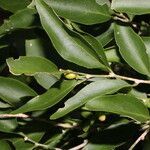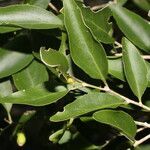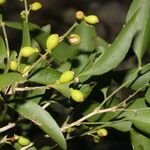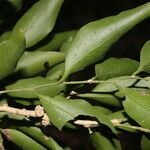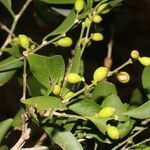Shrubs or trees, 1.3–7(–9) m; bark whitish, corky, fissured; branches striate, olive green to whitish, slender. Leaf blades lanceolate, ovate, or elliptic, 4–8 × 2–4 cm, brittle, base cuneate-attenuate to obtuse, apex acuminate, both surfaces shiny, ± tuberculate; venation brochidodromous, midrib sunken on both surfaces, lateral veins 4–6 pairs. Inflorescences 1–2 per axil, each a 2–3-flowered cyme or solitary flower; peduncle 1–4 mm. Flowers of two forms, pin and thrum; calyx rim entire or slightly lobed, 1 mm; corolla tube yellow or orange and lobes pink to red, urceolate to cylindric, 4.5 mm (pin flowers), cylindric to campanulate, (3.5–)4(–5) mm (thrum flowers); stigma 2–3-lobed, at or distal to included anthers (pin flowers) or proximal to exserted anthers (thrum flowers); ovary 2-locular in 4-merous flowers, 3-locular in 5-merous flowers. Drupes pink, orange, or red, subovoid to ellipsoid, (7–)10–13 × (6–)7–8 mm, with persistent rim of corolla at apex.
Unarmed glabrous shrubs or trees, reportedly root parasites. Leaves alternate, entire, coriaceous. Inflorescences few-flowered racemes generally fasciculate in the leaf axils, with or without basal perular bracts and the flowers subtended by a cupule composed of 2 bracteoles and 1 bract or subtended by a single bract. Flowers bisexual, small. Calyx extremely small, cyathiform or crateriform, margin subentire. Petals 3-6, united into a tubular-campanulate corolla, often pubescent within, the lobes valvate, reflexed, white, yellow or red. Stamens 3-6, in one whorl, as many as the petals, antipetalous, adnate to the corolla, the anthers oval, dehiscing longitudinally, sessile or short-filamented. Ovary half-immersed, the ovules pen-dulous, lacking integument, the style thin, the stigma 2-or 3-lobed. Spurious fruit with the drupe enclosed in the adnate, accrescent calyx, eccentrically annulate at the apex; seed with the small embryo at the tip of the endosperm.
